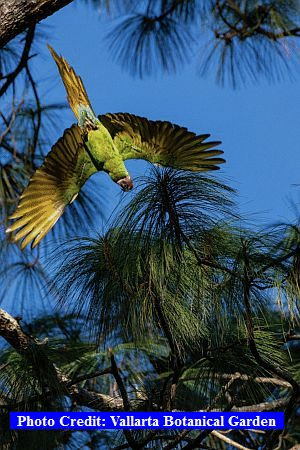Puerto Vallarta, Mexico - Late last month, while sitting at the balcony of the Vallarta Botanical Garden's Visitor Center with Board Member Ralph Osborne, a cacophony of raucous squawks brought our attention to the alarming sight of a large rainbow colored parrot on a wildly careening course right towards us. Fortunately, a few well-timed vigorous yet awkward flaps of its wings allowed it to veer off with only a near miss.
It continued on in this frightful a fumbling manner in a broad arc before finally landing at the giant pine near the top of the Garden's highest hill, all the while flanked by a pair of much more graceful, yet otherwise similar looking birds. I then lost sight of this menace on wings, as it quickly retreated to the refuge of its home, undoubtedly to recover from what was most assuredly its most exhilarating moment of its young life.
Ralph and I were left to then recover from our own shock as the lucky witnesses of what was obviously the first flight of one of the baby guacamayas (macaws) born in the Vallarta Botanical Garden just a few months back.
Military Macaws (Ara militaris) are by far the largest parrot of our region with lengths of up to approximately 85 cm and wingspans of well over a meter. This species has also unfortunately been one of the most aggressively targeted mass victims of poaching fueled by the illegal pet trade. Between this and the lost of its nesting habitat - hollowed out old pine trees - its numbers have dwindled and it has become a rare sight in the skies that it once dominated with great flocks.
Here in the Puerto Vallarta region, Macaws began a solid comeback after a senseless act of poaching in 2012 inspired the start of a grassroots macaw refuge, El Santuario de Las Guacamayas. This project, managed by Francisco Espino Ibarra and Jorge Novoa of the Ejido Las Juntas y Los Veranos now has over 15 artificial nest boxes installed throughout its pine forests and guests are often able to witness the flight of over 20 individual wild macaws during their visits there.
The Gardens, who quite literally helped Jorge and Francisco get their project off the ground, now have four nest boxes of their own, two of which are already occupied and appear to have successfully served as nest sites for rearing a new generation of young. The spread of this project proves that humans, who have driven this bird to the fringe in many parts of its range, now have the means to help it rebound and flourish once again.
Bird lovers, and especially those skilled at wildlife photography, are encouraged to help us capture some of these first flights in pictures and video. This may mean waiting for hours for just a few moments of excitement... but bearing witness to such spectacles is well worth your time and patience! Seeing such miracles of the wild with your own eyes helps keep life in the proper perspective.
 Visit the internationally famous Vallarta Botanical Garden located just 30 minutes south of Old Town at Km. 24 on Highway 200 and easily accessible by public transportation and taxi. This 64 acre wildlife preserve and botanical garden have something fun for everyone. Over 200 species of birds have been observed on the Garden's grounds. Don't forget to bring your swimsuit for a refreshing dip in the jungle river. See plantings of vanilla, chocolate, and hundreds of other botanical delights! Authentic Mexican Cuisine is served in the Hacienda de Oro Restaurant from 10 am to 5 pm. The Garden is open daily from 9 am to 6 pm (closed Mondays from April 1 to December 1). Garden admission is just $200 pesos. For more information, call (322) 223-6182 or visit vbgardens.org.
Visit the internationally famous Vallarta Botanical Garden located just 30 minutes south of Old Town at Km. 24 on Highway 200 and easily accessible by public transportation and taxi. This 64 acre wildlife preserve and botanical garden have something fun for everyone. Over 200 species of birds have been observed on the Garden's grounds. Don't forget to bring your swimsuit for a refreshing dip in the jungle river. See plantings of vanilla, chocolate, and hundreds of other botanical delights! Authentic Mexican Cuisine is served in the Hacienda de Oro Restaurant from 10 am to 5 pm. The Garden is open daily from 9 am to 6 pm (closed Mondays from April 1 to December 1). Garden admission is just $200 pesos. For more information, call (322) 223-6182 or visit vbgardens.org.Click HERE to learn more about Vallarta Botanical Gardens.



